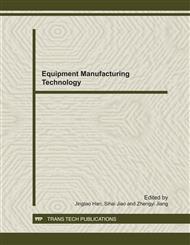p.3
p.10
p.17
p.24
p.29
p.35
p.39
p.43
3D Measurement Method Based on Binocular Vision and Linear Structured Light
Abstract:
To improve efficiency of industry inspection, measuring method of part shape which combines laser linear scanning and binocular vision is researched. In the system, two cameras are located at certain angle, and linear structured light is projected onto the part surface to produce distorted laser light stripe, which is used as measure feature curve. Ordinary planar plate is used as the calibration template in system calibration and images of serial parallel lines bundle are displayed on it which are acquired simultaneously by the camera to produce image series. Calibration parameters are divided into several parts, so as to calibration of them so that interference between different parts can be eliminated significantly. Based on above works, system calibration and reconstruction of 3D coordinate are implemented successfully. Experimental result shows our method’s feasibility and effectiveness, thus good prospect can be expected to it.
Info:
Periodical:
Pages:
17-23
Citation:
Online since:
December 2011
Authors:
Price:
Сopyright:
© 2012 Trans Tech Publications Ltd. All Rights Reserved
Share:
Citation:


